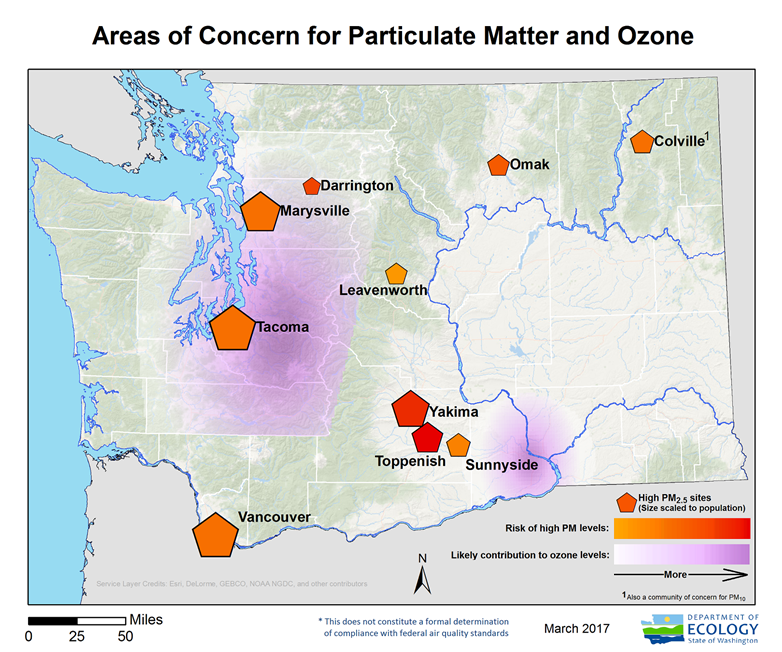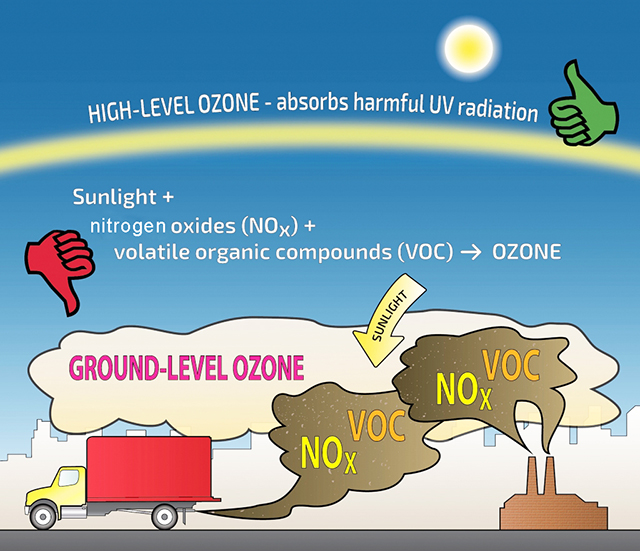Ground level ozone in Washington's air
We track ozone pollution in current air quality conditions (map). We monitor ozone at 13 locations to make sure levels are in the healthy range. Currently, all areas of Washington meet the national air quality standard for ozone. The Tri-Cities area is being closely monitored, because recent samples near Kennewick detected periods of relatively high ozone levels.
Click image to make it bigger.
Ozone
Ozone high in the Earth's atmosphere protects us from the sun's harmful radiation. But at ground level, ozone is an air pollutant that harms people and plants. Ground-level ozone forms when nitrogen oxides and volatile organic compounds react with each other in sunlight and hot temperatures. This pollution comes from vehicles, industry, and other sources and contributes to smog formation.
Ecology and local clean air agencies monitor air to ensure ground-level ozone meets Washington's air quality standards. Ozone levels used to exceed national standards in the Seattle and Vancouver areas. Due to improvements in vehicles and other emission-reducing requirements, ozone pollution has declined even as the population continues to grow.
Ozone in Washington
In the late 1970s and '80s, ozone levels downwind of some of Washington's urban areas were high enough to violate national air quality standards. Parts of Snohomish, King, Pierce, and Clark counties didn't meet the air quality standard because of high ozone levels.
By the mid-90s, all of Washington met the national standard. More protective emissions standards for vehicles, cleaner fuels, and gas station vapor controls helped reduce ozone pollution.
Generally, ozone levels tend to be higher downwind of urban areas. This is because it takes a while for pollutants to react with sunlight. Although Washington currently meets the ozone standard, we continue to watch the following areas closely:
- Western foothills of Cascade Mountains
- Tri-Cities area (Kennewick, Pasco, and Richland)

Ecology and local clean air agencies monitor air pollution in Washington. This map shows areas of concern we are monitoring closely.
Maintaining clean air
To make sure air continues to meet Washington standards, we partner with local clean air agencies to monitor ozone at 13 locations. We monitor ozone at:
- Urban locations (Seattle, Vancouver, and Spokane)
- Downwind of urban locations (eight sites)
- Natural rural location (Olympic Peninsula)
- High elevation location (Mt. Rainier)
Federal ozone standards
In December 2020, EPA decided to keep the existing air quality standard for ozone. The standard was originally adopted in 2015. In September 2020, we recommended that EPA adopt more protective standards for ozone pollution.
What you can do
To help prevent ozone from forming on hot days:
- Don't drive unless you have to. Share a ride, take the bus, ride your bike, or walk when you can. If you must drive, combine your trips.
- Refuel your car or truck after dusk. Don't top off your tank.
- Limit engine idling.
- Put off using gasoline-powered lawn and garden equipment until the hot spell is over.
- Don't use your barbecue or fire pit.
- Conserve electricity. Set your air conditioner at a higher temperature.
- Save that painting project for later. Don't use paint or other products that release solvent gases.
When pollution rises on hot days:
- Cut down on strenuous physical activity outside.
- Stay inside until it cools down outside.
Ozone damages trees and plants. It impairs plant growth, and makes them more easily harmed by insects and disease.
Ground-level ozone irritates the eyes, nose, throat, and respiratory system. It's especially bad for those with chronic heart and lung disease (like asthma, bronchitis, and emphysema), children and the elderly, as well as pregnant women.
Coughing and throat/chest irritation
High levels of ozone can irritate your respiratory system. Mild symptoms usually last for a short time after exposure. However, if levels remain high, then ozone can continue to harm your lungs even after symptoms disappear.
Difficulty breathing and lung damage
Ozone aggressively attacks lung tissue. You might think of it as sunburn on your lungs. It can make it hard to breathe, especially during exercise.
Worsening asthma symptoms
Exposure to high levels of ozone can trigger asthma attacks.
Contact information
Cooper Garbe
Rules & Planning Unit
cooper.garbe@ecy.wa.gov
360-485-7216


